 Open Access Article
Open Access ArticleCreative Commons Attribution 3.0 Unported Licence
Correction: Implantation of a functional TEMPO-hydrogel induces recovery from rat spinal cord transection through promoting nerve regeneration and protecting bladder tissue
Yu
Zhang
a,
Liming
Li
ab,
Jiafu
Mu
a,
Jiachen
Chen
a,
Shiqing
Feng
cd and
Jianqing
Gao
*ab
aInstitute of Pharmaceutics, College of Pharmaceutical Sciences, Zhejiang University, Hangzhou, People's Republic of China. E-mail: gaojianqing@zju.edu.cn
bDr. Li Dak Sum & Yip Yio Chin Center for Stem Cell and Regenerative Medicine, Zhejiang University, Hangzhou, People's Republic of China
cDepartment of Orthopedics, Tianjin Medical University General Hospital, Tianjin, People's Republic of China
dTianjin Neurological Institute, Key Laboratory of Post-Neuroinjury Neuro-repair and regeneration in Central Nervous System, Ministry of Education and Tianjin City, Tianjin, People's Republic of China
First published on 7th September 2022
Abstract
Correction for ‘Implantation of a functional TEMPO-hydrogel induces recovery from rat spinal cord transection through promoting nerve regeneration and protecting bladder tissue’ by Yu Zhang et al., Biomater. Sci., 2020, 8, 1695–1701, https://doi.org/10.1039/C9BM01530B.
The authors regret that an incorrect panel was displayed in Fig. 2D. The corrected Fig. 2 is as shown below.
The Royal Society of Chemistry apologises for these errors and any consequent inconvenience to authors and readers.
| This journal is © The Royal Society of Chemistry 2022 |

